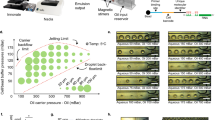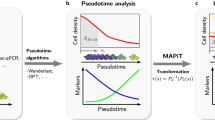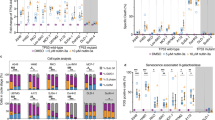Abstract
Synchronization of cells and nuclei is a powerful technique for the exact study of regulatory mechanisms and for understanding cell cycle events. Counterflow centrifugal elutriation is a biophysical cell separation technique in which cell size and sedimentation density differences of living cells are exploited to isolate subpopulations in various stages of cell cycle. Here, a protocol is described for the separation of phase-enriched subpopulations from exponentially growing Chinese hamster ovary cells at high-resolution power of elutriation. The efficiency of elutriation is confirmed by measuring the DNA content fluorimetrically and by flow cytometry. The resolution power of elutriation is demonstrated by the ability to fractionate nuclei of murine pre-B cells. The installation and elutriation by collecting 16–30 synchronized fractions, including particle size analysis, can be achieved in 4–5 h.
This is a preview of subscription content, access via your institution
Access options
Subscribe to this journal
Receive 12 print issues and online access
$259.00 per year
only $21.58 per issue
Buy this article
- Purchase on Springer Link
- Instant access to full article PDF
Prices may be subject to local taxes which are calculated during checkout




Similar content being viewed by others
References
Uzbekov, R.E. Analysis of the cell cycle and a method employing synchronized cells for study of protein expression at various stages of the cell cycle. Biochemistry 69, 485–496 (2004).
Griffin, M.J. Synchronization of some human cell strains by serum and calcium starvation. In Vitro 12, 393–398 (1976).
Tobey, R.A., Oishi, N. & Crissman, H.A. Cell cycle synchronization: Reversible induction of G2 synchrony in cultured rodent and human diploid fibroblasts. Proc. Natl Acad. Sci. USA 87, 5104–5108 (1990).
Holley, R.W. & Kiernan, M.A. 'Contact inhibition' of cell division in 3T3 cells. Proc. Natl. Acad. Sci. USA 60, 300–304 (1968).
Pardee, A.B. & Keyomarsi, K. Modification of cell proliferation with inhibitors. Curr. Opin. Cell Biol. 4, 186–191 (1992).
Tobey, RA. & Crissman, H.A. Use of flowmicrofluorimetry in detailed analysis of effects of chemical agents on cell cycle progression. Cancer Res. 32, 2726–2732 (1972).
Vogel, W., Schempp, W. & Sigwarth, I. Comparison of thymidine, fluorodeoxyuridine, hydroxyurea, and methotrexate blocking at the G1/S phase transition of the cell cycle, studied by replication patterns. Hum. Genet. 45, 193–198 (1978).
Fox, M.H., Read, R.A. & Bedford, J.S. Comparison of synchronized Chinese hamster ovary cells obtained by mitotic shake-off, hydroxyurea, aphidicolin, or methotrexate. Cytometry 8, 315–320 (1987).
Matherly, L.H., Schuetz, J.D., Westin, E. & Goldman, I.D. A method for the synchronization of cultured cells with aphidicolin: application to the large-scale synchronization of L1210 cells and the study of the cell cycle regulation of thymidylate synthase and dihydrofolate reductase. Anal. Biochem. 182, 338–345 (1989).
Kumagai-Sano, F., Hayashi, T., Sano, T. & Hasezawa, S. Cell cycle synchronization of tobacco BY-2 cells. Nat. Protoc. 1, 2621–2627 (2006).
Robbins, E. & Marcus, P.I. Mitotically synchronized mammalian cells: a simple method for obtaining large populations. Science 144, 1152–1153 (1964).
Cohen, L.S. & Studzinski, G.P. Correlation between cell enlargement and nucleic acid and protein content of HeLa cells in unbalanced growth produced by inhibitors of DNA synthesis. J. Cell Physiol. 69, 331–339 (1967).
Terasima, T. & Tolmach, L.J. Growth and nucleic acid synthesis in synchronously dividing populations of HeLa cells. Exp. Cell Res. 30, 344–362 (1963).
Urbani, L., Sherwood, S.W. & Schimke, R.T. Dissociation of nuclear and cytoplasmic cell cycle progression by drugs employed in cell synchronization. Exp. Cell Res. 219, 159–166 (1995).
Sloot, P.M.A., van der Donk, E.H.M. & Figdor, C.G. Computer assisted centrifugal elutriation II: Multiparametric statistical analysis. Comp. Meth. Progr. Biomed. 37–46 (1988).
Mitchell, B.F. & Tupper, J.T. Synchronization of mouse 3T3 and SV40 3T3 cell by way of centrifugal elutriation. Exp. Cell Res. 106, 351–355 (1977).
Oredsson, S.M., Gray, J.W. & Marton, L.J. Progressive increase in polyamine levels in 9L cells in vitro during the cell cycle: comparison between cells isolated by centrifugal elutriation and cells grown in synchrony. Cell Tissue Kinet. 17, 437–444 (1984).
Cymerman, U. & Beer, J.B. Some problems in using density gradient centrifugation for synchronization of L5178Y-S cells. Neoplasma 27, 429–436 (1980).
Guidozzi, F. Enrichment of ovarian cancer cell suspensions by centrifugal elutriation after density gradient purification. Int. J. Gynecol. Cancer 7, 100–105 (1997).
de Carvalho, C.M. et al. Evaluation of elutriation and magnetic microbead purification of canine monocytes. Vet. Immunol. Immunopathol. 101, 171–178 (2004).
Grdina, D.J., Meistrich, M.L., Meyn, R.E., Johnson, T.S. & White, R.A. Cell synchrony techniques. I. A comparison of methods. Cell Tissue Kinet. 17, 223–236 (1984).
Rice, G.C., Dean, P.N., Gray, J.W. & Dewey, W.C. An ultra-pure in vitro phase synchrony method employing centrifugal elutriation and viable flow cytometric cell sorting. Cytometry 5, 289–298 (1984).
Banfalvi, G., Nagy, G., Gacsi, M., Roszer, T. & Basnakian, A. Common pathway of chromatin condensation in mammalian cells. DNA Cell Biol. 25, 295–301 (2006).
Rehak, M., Csuka, I., Szepessy, E. & Banfalvi, G. Subphases of DNA replication in Drosophila cells. DNA Cell Biol. 19, 607–612 (2000).
Banfalvi, G. Structure of interphase chromosomes in the nuclei of Drosophila cells. DNA Cell Biol. 25, 547–553 (2006).
Lindahl, P.E. Principle of a counter-streaming centrifuge for the separation of particles of different sizes. Nature 161, 648–649 (1948).
Lindahl, P.E. On counter streaming centrifugation in the separation of cells and cell fragments. Biochim. Biophys. Acta. 21, 411–415 (1956).
Sanderson, R.J., Bird, K.E., Palmer, N.F. & Brenman, J. Design principles for a counterflow centrifugation cell separation chamber. Appendix: a derivation of the equation of motion of a particle under combined centrifugal and hydrodynamic fields. Anal. Biochem. 71, 615–622 (1976).
Meistrich, M.L. Experimental factors involved in separation by centrifugal elutriation. in Cell Separation Vol. 2. (eds. Pretlow, T.G. II. & Pretlow, T.P.) 33–61 (Academic Press, New York, 1983).
Kauffman, M.G., Noga, S.J., Kelly, T.J. & Donnenberg, A.D. Isolation of cell cycle fractions by counterflow centrifugal elutriation. Anal. Biochem. 191, 41–46 (1990).
Bauer, J. Advances in cell separation: recent developments in counterflow centrifugal elutriation and continuous flow cell separation. J. Chromatogr. B. Biomed. Sci. Appl. 722, 55–69 (1999).
Chianéa, T., Assidjo, N.E. & Cardot, P.J.P. Sedimentation field-flow-fractionation: emergence of a new cell separation methodology. Talanta 51, 835–847 (2000).
Dorin, M. Developing elutriation protocols. Technical Paper T-1785A. Beckman Instruments Inc., Fullerton, California, (1994).
Barford, J.P. A mathematical model for cell separation technique of centrifugal elutration. Biotechnol. Bioeng. 38, 570–577 (1986).
Stokes, G.G, On the effect of the internal friction of fluids on the motion of pendulums. Cambridge Philos. Trans. 9, 8–106 (1851).
Offer, H. et al. p53 modulates base excision repair activity in a cell cycle specific manner following genotoxic stress. Cancer Res. 61, 88–96 (2001).
Kaufmann, W.K. & Wilson, S.J. DNA repair endonuclease activity during synchronous growth of diploid human fibroblasts. Mutation Res. 236, 107–117 (1990).
Banfalvi, G. et al. Effect of cadmium on the relationship between replicative and repair DNA synthesis in synchronized CHO cells. Eur. J. Biochem. 267, 6580–6585 (2000).
Coulter, W.H. High speed automatic blood cell counter and cell size analyzer. Proc. Natl. Electron. Conf. 12, 1034–1040 (1957).
Riccardi, C. & Nicoletti, I. Analysis of apoptosis by propidium iodide staining and flow cytometry. Nat. Protoc. 1, 1458–1461 (2006).
Doleel, J., Greilhuber, J. & Suda, J. Estimation of nuclear DNA content in plants using flow cytometry. Nat. Protoc. 2, 2233–2244 (2007).
Terry, N.H.A. & White, R.A. Flow cytometry after bromodeoxyuridine labeling to measure S and G2.M phase durations plus doubling times in vitro and in vivo. Nat. Protoc. 1, 859–869 (2006).
Perfetto, S.P., Ambrozak, D., Nguyen, R., Chattopadhyay, P. & Roederer, M. Quality assurance for polychromatic flow cytometry. Nat. Protoc. 1, 1522–1530 (2006).
Schmid, I., Uittenbogaart, C. & Jamieson, B.D. Live-cell assay for detection of apoptosis by dual-laser flow cytometry using Hoechst 33342 and 7-amino-actinomycin D. Nat. Protoc. 1, 187–190 (2006).
Mukhopadhyay, P. et al. Simultaneous detection of apoptosis and mitochondrial superoxide production in live cells by flow cytometry and confocal microscopy. Nat. Protoc. 2, 2295–2301 (2007).
Ferlini, C. & Scambia, G. Assay for apoptosis using the mitochondrial probes, Rhodamine123 and 10-N-nonyl acridine orange. Nat. Protoc. 2, 3111–3114 (2007).
van Genderen, H. et al. In vitro measurement of cell death with the annexin A5 affinity assay. Nat. Protoc. 1, 363–367 (2006).
Troiano, L. et al. Multiparametric analysis of cells with different mitochondrial membrane potential during apoptosis by polychromatic flow cytometry. Nat. Protoc. 2, 2719–2727 (2007).
Quah, B.J.C., Warren, H.S. & Parish, C.R. Monitoring lymphocyte proliferation in vitro and in vivo with the intracellular fluorescent dye carboxyfluorescein diacetate succinimidyl ester. Nat. Protoc. 2, 2049–2056 (2007).
Chattopadhyay, P.K., Yu, J. & Roederer, M. Live-cell assay to detect antigen-specific CD4+ T-cell responses by CD154 expression. Nat. Protoc. 1, 1–6 (2006).
Pittet, M.J., Swirski, F.K., Reynolds, F., Josephson, L. & Weissleder, R. Labeling of immune cells for in vivo imaging using magnetofluorescent nanoparticles. Nat. Protoc. 1, 73–79 (2006).
Basnakian, A., Banfalvi, G. & Sarkar, N. Contribution of DNA polymerase delta to DNA replication in permeable CHO cells synchronized in S phase. Nucleic Acids Res. 17, 4757–4767 (1989).
Banfalvi, G. et al. Cell culture dependent toxicity and chromatin changes upon cadmium treatment in murine pre-B cells. Apoptosis 12, 1219–1228 (2007).
Munyard, K.A. & Baker, S.K. Size fractionation of a rumen microbial population by countercurrent centrifugal elutriation. J. Microb. Meth. 67, 3566–3573 (2006).
Szepessy, E. et al. Multiple subphases of DNA repair and poly(ADP-ribose) synthesis in Chinese hamster ovary (CHO-K1) cells. Eur. J. Cell Biol. 82, 201–207 (2003).
Barker, S., Murray, D., Zheng, J., Li, L. & Weinfeld, M. A method for the isolation of covalent DNA–protein crosslinks suitable for proteomics analysis. Anal. Biochem. 344, 204–215 (2005).
Acknowledgements
The research related to elutriation was supported by the OTKA grant T042762 (G.B.).
Author information
Authors and Affiliations
Corresponding author
Rights and permissions
About this article
Cite this article
Banfalvi, G. Cell cycle synchronization of animal cells and nuclei by centrifugal elutriation. Nat Protoc 3, 663–673 (2008). https://doi.org/10.1038/nprot.2008.34
Published:
Issue Date:
DOI: https://doi.org/10.1038/nprot.2008.34
This article is cited by
Comments
By submitting a comment you agree to abide by our Terms and Community Guidelines. If you find something abusive or that does not comply with our terms or guidelines please flag it as inappropriate.



